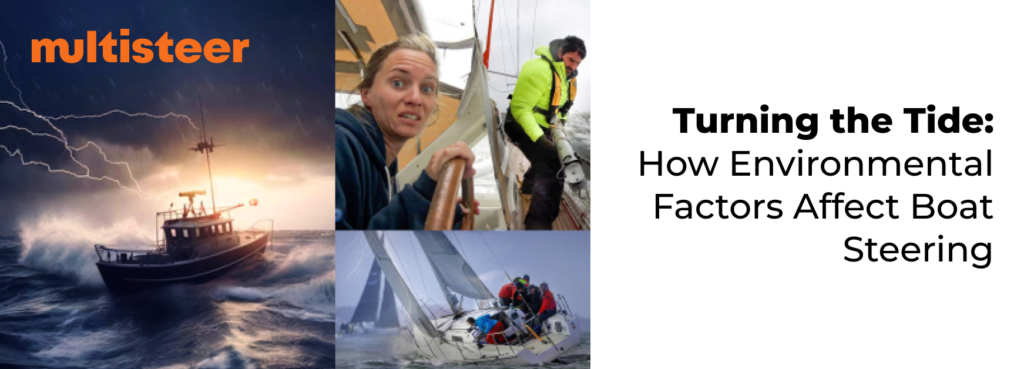Boat navigation is an art and science that has been honed for centuries, with skilled mariners deftly maneuvering their vessels through waterways of all kinds. The precision required to steer a boat is not solely reliant on the captain’s skill, as environmental factors play a significant role in the successful navigation of watercraft. This article explores how environmental conditions impact boat steering and the strategies employed by experienced mariners to effectively navigate these challenges
1. Wind
Wind is one of the most prominent environmental factors that affect boat steering. The force and direction of the wind can significantly alter a boat’s course. When the wind blows from the port side (the port side of the boat when facing forward), it pushes the boat to the starboard side (the right side) and vice versa. This is known as wind-induced “lee helm” or “weather helm.”
Experienced boat operators use the wind to their advantage by adjusting sails and rudder positions to counteract the wind’s influence. Modern sailing vessels typically employ sail trim controls, like the jib and mainsail, to maintain proper balance. Powerboats rely on rudder adjustments to counteract wind-induced steering issues.
2. Currents
Water currents, both tidal and riverine, are another significant factor in boat steering. Currents can vary in speed and direction, making it challenging for captains to maintain a consistent course. Tidal currents are particularly influential near coastal areas, as they change direction with the rise and fall of the tide.
Skilled mariners monitor tide tables and consult navigational charts to understand the patterns of currents in a given area. In some cases, itadjusting the boat’s heading or throttle may be necessary compensate for strong currents and ensure a safe and efficient voyage.
3. Waves
Waves, whether generated by wind, tides, or other factors, can have a profound impact on boat steering. Large waves can cause a boat to roll or pitch, making it challenging to maintain a stable course. Smaller, choppier waves can also create discomfort for passengers and hinder a captain’s ability to navigate effectively.
To mitigate the effects of waves, boat operators often adjust their course to align with the direction of the waves, reducing the risk of capsizing. In some cases, boats may reduce speed to maintain stability and passenger comfort.
4. Weather Conditions
Weather conditions, including fog, rain, and storms, can significantly affect visibility and, consequently, boat steering. Reduced visibility can make navigation perilous, increasing the risk of collisions with other vessels or obstacles.
In adverse weather conditions, mariners rely heavily on navigation instruments like GPS, radar, and sonar to maintain a steady course and ensure their safety. Additionally, sound judgment and experience are crucial in making timely decisions to respond to changing weather conditions.
5. Obstacles and Hazards
The presence of obstacles and hazards, such as rocks, shoals, and submerged debris, poses a significant threat to boat steering. These environmental factors can disrupt a vessel’s course or cause damage to the hull and propulsion systems.
To navigate safely in areas with known obstacles, mariners rely on navigational aids like buoys, lights, anmarkers, updated charts,nd GPS technology. Proper training and awareness are essential to avoiding collisions and damage.
How Multisteer Steering Systems Perform in Various Weather Conditions
Incorporating Multisteer steering systems into the discussion of environmental factors affecting boat steering is essential, as these systems have proven to be a game-changer in navigating challenging conditions. Multisteer systems, featuring advanced control mechanisms, offer enhanced performance in the face of adverse weather. When dealing with wind, currents, waves, or inclement weather, boat operators can rely on the precision and adaptability of these systems to maintain course and ensure safety.
In windy conditions, Multisteer steering systems provide captains with the tools to counteract wind-induced steering issues with precision. It allows real-time effortless direction control of each engine and rudder, optimizing the boat’s response to the wind’s influence.
When navigating through strong currents, these systems offer the advantage of adjusting rudder angles with minimal effort, granting operators the control they need to stay on course.
In rough seas with significant waves, Multisteer systems excel in providing stability and control. Their ability to counteract rolling and pitching ensures both passenger comfort and safety.
Incorporating Multisteer steering systems into boat navigation has revolutionized how mariners handle environmental factors. With enhanced precision, automation, and control, Multisteer Steering Systems enable captains to effectively manage the boats effectively, turning challenging weather conditions into manageable elements of their journey.
Conclusion
Boat steering is a complex skill that requires the ability to adapt to ever-changing environmental conditions. Wind, currents, waves, weather, and obstacles all pose unique challenges to mariners. Experienced boat operators develop the knowledge and skills needed to navigate effectively and safely in any situation.
The art of boat steering is a testament to the seamanship and resourcefulness of mariners throughout history. By understanding and respecting the impact of environmental factors, both modern and traditional boaters can turn the tide in their favor, ensuring safe and successful navigation through the world’s waterways.
To Know More click here: https://multisteer.com/
Follow our social media pages for more updates: Facebook | Instagram | Twitter | Linkedin | Youtube
#Multisteer #Hydraulicsteering #Boating #Marine #Power #Steerlyteplus #boatsteeringkit #powerassisted #hydraulic #steeringsystem #portugal #Australia #NewZealand #SaudiArabia #Indonesia #Nigeria #Italy #France #Spain #Russia #Norway #SouthAfrica #Philippines #Vietnam #Thailand #Singapore #Finland #Poland #UK #HongKong

